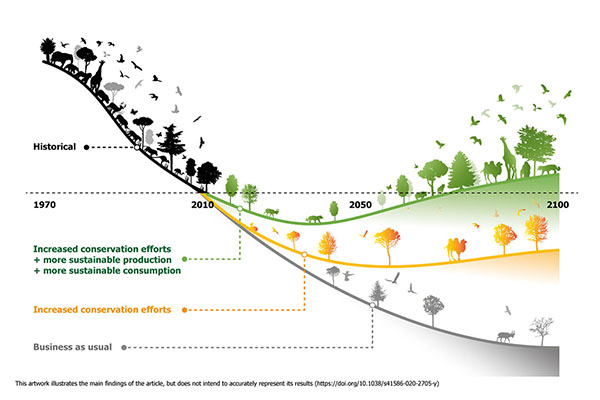By Neil Burgess
It’s clear that we need urgent, transformative change to tackle the global nature crisis. In many cases, we already know the solutions. How to stop terrestrial biodiversity loss from habitat conversion is one such case, and it has implications for the entire SDG framework.
Last week, the UN Convention for Biological Diversity’s (CBD) Global Biodiversity Outlook 5 reported that of the 20 Aichi targets agreed in 2010, only six are being “partially achieved” by their 2020 deadline. The CBD warns that despite encouraging progress in several areas, the natural world is suffering badly and getting worse. Launched in the same week, WWF’s Living Planet Report found that the population sizes of mammals, birds, fish, amphibians, and reptiles have seen an average drop of 68% since 1970.
How can we halt biodiversity loss from land use change while feeding a growing population?
The good news is that the scientific community has made great progress in defining the problem over the past decade; we now have a clear and robust evidence base showing the urgency of changing course. There has also been massive progress in scientifically defining what needs to be done. A prime example of this is our knowledge of how to halt and reverse terrestrial biodiversity loss from land use change.
A third recent study, published in Nature on 10 September, shows the possibility of halting and reversing terrestrial biodiversity loss caused by land use change.

Image credit: Leclere et al, Nature
Six Actions to Halt and Recover from Terrestrial Biodiversity Loss
The new study was led by David Leclere of the International Institute for Applied Systems Analysis (IIASA) and involved 58 experts from across 46 institutions including the UN Environment Programme World Conservation Monitoring Centre (UNEP-WCMC). It projects that without further efforts to tackle habitat loss and degradation, global biodiversity decline will continue at a rate close to or greater than that for 1970-2010. Land use change, also known as habitat conversion, is one of the main drivers of biodiversity loss on land. The researchers used ground-breaking modelling and newly developed scenarios to identify six actions needed to stop such losses. These are:
- Sustainable increases in crop yields;
- Trade increases in agricultural goods with reduced trade barriers;
- Reducing the waste of agricultural goods from field to fork by 50%;
- Cutting the share of animal calories in human diets by 50% except in regions in which the share of animal products in diets is already estimated to be low (the Middle East, sub-Saharan Africa, India, Southeast Asia, and other Pacific Islands);
- Increasing Protected Area extent to 40% terrestrial coverage, covering important sites for biodiversity and with improved management; and
- Increasing restoration (reaching about 8% of terrestrial areas by 2050) and landscape-level conservation planning that balances production and conservation objectives on all managed land.
By combining the six actions listed above in an integrated strategy, modelling shows that it is possible to avoid more than two thirds of future terrestrial biodiversity losses caused by land use change.
Protecting SDGs 2 (Zero Hunger) and 15 (Life on Land) at the Same Time
The authors of the study considered seven different scenarios to explore whether we could achieve this without undermining other SDGs. In particular, how can we halt biodiversity loss from land use change while also feeding a growing population?
Without transformation of the food system, bold conservation efforts could conflict with future food provision by raising food prices. The conservation efforts alone would also not be enough to stop the losses by 2050. In order to achieve this and reduce potential negative impacts on food security, conservation efforts should be combined with simultaneous transformation of food systems, as well as wider action on other drivers of biodiversity loss, such as climate change and biological invasions.
Such transformative change in food and land use systems would also have valuable co-benefits that contribute to other SDGs, such as SDG 13 (climate action), SDG 6 (clean water and sanitation), and SDG 3 (good health and wellbeing).
Implications for International Policy
This is the first time that the key combined actions needed to stop and reverse biodiversity loss on land have been identified and backed by robust futures modelling. This research sets out clear and ambitious actions for governments, businesses, and consumers to take on board.
The next Conference of the Parties to the Convention on Biological Diversity (CBD) in 2021 (COP 15) is expected to agree a set of new international goals and targets as part of a post-2020 global biodiversity framework to take us through to 2050. The post-2020 global biodiversity framework will be a critical opportunity to stop biodiversity loss and ensure that people continue to benefit from biodiversity into the future. But for this framework to be effective, it must incorporate bold conservation and restoration efforts as well as food system transformation. Together these can help to tackle the drivers of terrestrial biodiversity loss.
The author of this guest article, Neil Burgess, is Chief Scientist of the UN Environment Programme World Conservation Monitoring Centre (UNEP-WCMC).